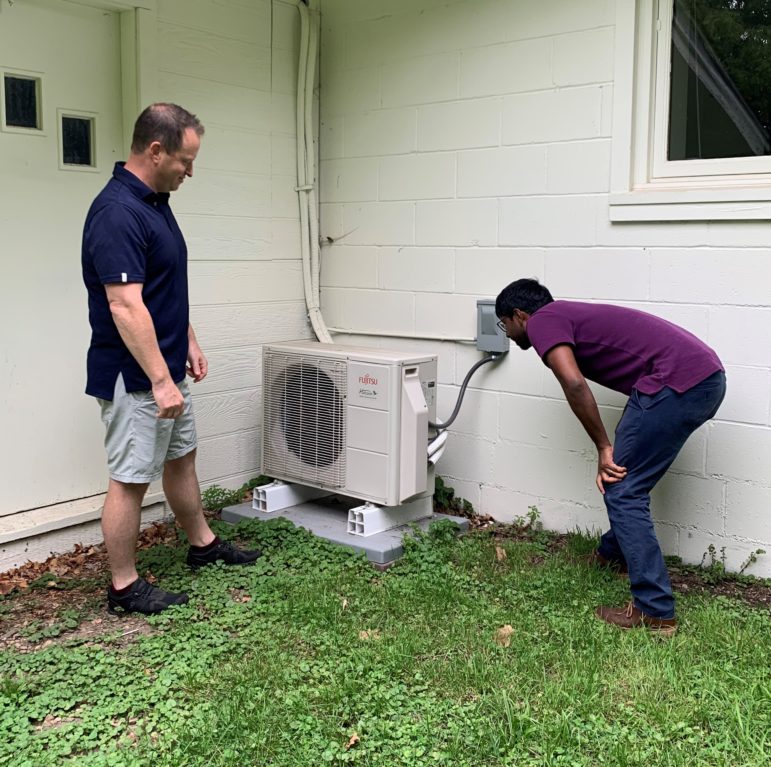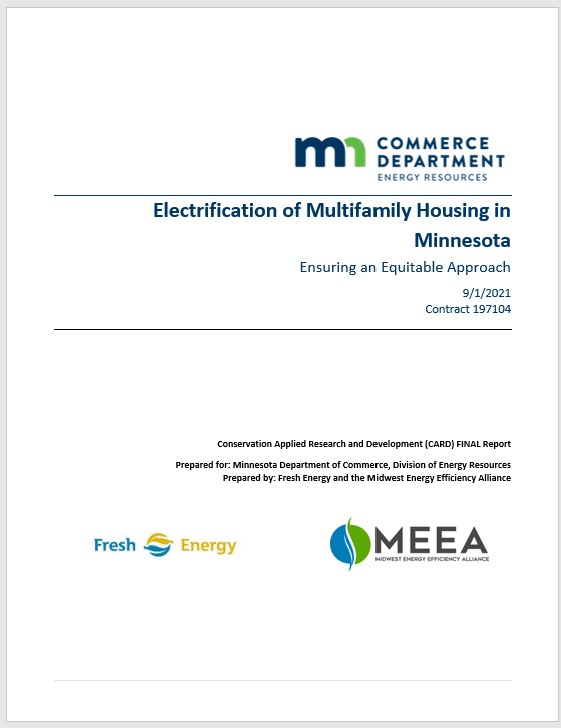Key considerations as we shift our buildings away from fossil fuels.

Greenhouse gas emissions from the building sector in Minnesota—including where we live, work, relax, and shop—are on the rise and as we work together across the state to reduce the worst impacts of climate change, tackling the emissions from our buildings presents a major opportunity.
Significant progress is being made to decarbonize the electricity sector by closing coal plants and adding more renewables like wind and solar. In fact, Fresh Energy has an entire team and strategic imperative to support this work. As a result, our electricity is growing cleaner and cleaner, and we must also shift our “end use” energy sectors—like buildings and transportation—to use more of this cleaner electricity rather than fossil fuels. This is another of the strategic imperatives that guides Fresh Energy’s work.
Residential buildings in particular are vital to “electrify” given their rising contributions to Minnesota’s greenhouse gas (GHG) emissions. Accordingly, we must invest more in the decarbonization—in this case, electrification—of residential buildings.

What does it mean to “electrify” a building? Electrification is switching from fossil natural gas, wood, and propane as fuel sources to using electricity as a fuel source. An example of this concept is switching from a furnace that runs on fossil natural gas to a heat pump that relies on electricity. In 2020, Fresh Energy served on a technical advisory committee as part of a stakeholder process convened by the Minnesota Department of Commerce and facilitated by Michael’s Energy (a Wisconsin-based energy consulting firm) to strategize on building electrification opportunities in Minnesota. As takeaways from these meetings were compiled and formalized, the facilitators realized that certain areas needed to be further explored and multifamily housing, like apartments and condos, were one of those areas. The charge to Fresh Energy and partners was to draft a short report that would provide an overview of electrification in multifamily housing and highlight major factors for decision-makers and other interested parties to consider as electrification plans unfold in Minnesota. Thus, the white paper, “Electrification of Multifamily Housing in Minnesota,” was written. View a PDF of the white paper here.
At the heart of this paper is the belief that equity must remain at the very forefront of the energy transition away from fossil fuels. Multifamily housing is just one slice of the decarbonization pie; each solution toward clean energy in every sector of our economy requires this acknowledgment if we are to ensure a just transition.
Below are some key considerations taken from the paper to guide an equitable approach to electrification in multifamily buildings in Minnesota.
Major benefits of electrifying multifamily housing:
- Mitigate climate change impacts by decreasing the state’s greenhouse gas emissions from the buildings sector, a move which supports Minnesota’s goal of 100% clean electricity by 2040.
- Reduce the energy burdens—both financial and health— of historically marginalized people by prioritizing under-resourced households to increase resilience. This means multifamily housing should be affordable over the long-term, all while being super efficient, gas-free, and healthy.
- Non-energy benefits for those living and working in buildings will increase as the shift to electrification reduces indoor air pollution and increases comfort, safety, and wellbeing.
Barriers to electrification:
- Manage the “split incentive” or the challenge to balance the interests and what’s best for both the renter and the property owner, recognizing that both parties need to benefit from electrification.
- Acknowledge the complex and resource-intensive process of retrofitting existing buildings for energy efficiency and electrification through coordinating with residents in the building and streamlining available programs with proper knowledge, technical assistance, and contractor training.
- Secure enough funds to cover the cost of capital improvements and deep retrofits which can include electrical updates, removing outdated insulation, and more, while protecting renters from rent increases which could lead to displacement and gentrification.
Further opportunities for electrification:
The recently passed Energy Conservation and Optimization (ECO) Act is a great start to realizing new opportunities for electrification. It now allows utilities to incentivize fuel-switching (changing one source of energy to a different source, e.g. from fossil natural gas to electricity) and requires utilities to invest more money into programs serving under-resourced households, among other things. While the ECO Act is an important first step, there is much more to be done to advance building electrification in Minnesota. We must also:
- Modernize and update building codes to reflect Minnesota’s climate goals and help to expedite further electrification.
- Co-create programs and incentives alongside community partners while ensuring equity is not only a part of the outcome, but also a part of the process and decision-making.
- Increase effective funding from existing sources for programs and incentives in order to cover the capital needed for electrification upgrades.
- Utilize legislation as a tool for policy change and implementation, as demonstrated by the ECO Act.
- Shape local government strategies through programs, partnerships, and other incentives to further advance electrification efforts.

A final takeaway for Fresh Energy and our partners is that the considerations listed above and in the white paper are not exhaustive. There are many technical and nuanced details that must be sorted out along the way and Fresh Energy is looking forward to being part of that process. This is simply the start to a more robust conversation that we and our partners will continue to have as we advocate for a just transition toward a carbon-free future.
Acknowledgments:
Fresh Energy would like to thank Maddie Wazowicz from the Midwest Energy Efficiency Alliance, Katherine Teiken, and Ben Passer for their partnership and contributions to this paper.
This material is based upon work supported by the U.S. Department of Energy’s Office of Energy Efficiency and Renewable Energy (EERE) under the Weatherization and Intergovernmental Programs Office Award Number DE-EE0008608.
Disclaimer: This report was prepared as an account of work sponsored by an agency of the United States Government. Neither the United States Government nor any agency thereof, nor any of their employees, makes any warranty, express or implied, or assumes any legal liability or responsibility for the accuracy, completeness, or usefulness of any information, apparatus, product, or process disclosed, or represents that its use would not infringe privately owned rights. Reference herein to any specific commercial product, process, or service by trade name, trademark, manufacturer, or otherwise does not necessarily constitute or imply its endorsement, recommendation, or favoring by the United States Government or any agency thereof. The views and opinions of authors expressed herein do not necessarily state or reflect those of the United States Government or any agency thereof.
